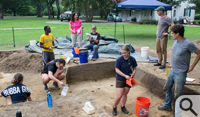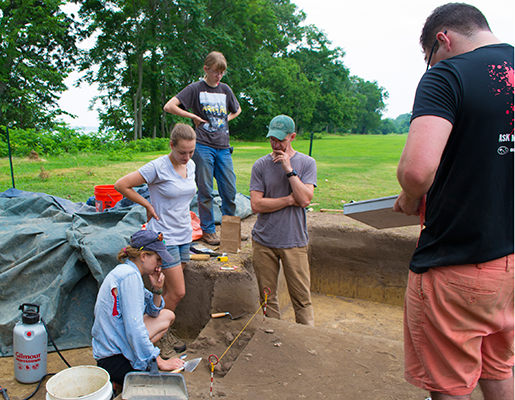Understanding Kiskiack
Archaeology uncovers insights on Indian town visited by John Smith
It was the last day of the dig and rain was threatening.
Madeline Gunter and Jessica Bittner were using tablespoons to work around some rocks that were just beginning to peek through the troweled-flat, muddy-looking surface of their working unit. They weren’t just random stones.
“It’s a hearth feature,” said Gunter, a Ph.D. student in William & Mary’s Department of Anthropology. “We’re making sure to collect all these little charcoal flecks that are concentrated here in the center. That’s going to help us date this feature.”
Rain, even a very moderate shower, would wash away those little charcoal flecks, along with any microscopic evidence of foodstuffs mixed in among them. As a precaution, Gunter and Bittner work with tarps literally at their elbows, the unsettled weather adding a bit of extra urgency to the excavation.
The hearth feature was one of the top finds of the summer archaeological field school conducted by Professor of Anthropology Martin Gallivan at Kiskiack, the site of an Indian town that was once part of the chiefdom of Powhatan, the father of Pocahontas.
 It’s possible that John Smith or Pocahontas ate a meal cooked on the very same hearth that Gunter and Bittner were excavating, but it would be fanciful to say so. Gallivan says that the odds of both time and place are against such an occurrence. Kiskiack may have been occupied for centuries at the time that Smith and the other Jamestown colonists arrived in 1607. In addition, the site extends for hundreds of yards along a bluff overlooking the York River, on the grounds of what now is Naval Weapons Station Yorktown, and no doubt the ground underneath contains many, many hearth features of various vintages.
It’s possible that John Smith or Pocahontas ate a meal cooked on the very same hearth that Gunter and Bittner were excavating, but it would be fanciful to say so. Gallivan says that the odds of both time and place are against such an occurrence. Kiskiack may have been occupied for centuries at the time that Smith and the other Jamestown colonists arrived in 1607. In addition, the site extends for hundreds of yards along a bluff overlooking the York River, on the grounds of what now is Naval Weapons Station Yorktown, and no doubt the ground underneath contains many, many hearth features of various vintages.
Looking for clues about food
The archaeologists hope that laboratory examination of the hearth area will not only help to date the feature, but also yield up clues about what was eaten there at the time. The hearthstones are lumps of quartzite, brought down the York River from Virginia’s mountains by long years of weathering and flooding. Some of the hearthstones look like brick fragments, but they’re not.
“You see these red stones, here?” Gunter asked. “That’s one of the indications that it’s a hearth feature, because when these rocks are exposed to a certain temperature, they turn this red color.”
As hearths tend to be a central aspect of Indian domestic life, the material recovered from between the stones can be more interesting than the hearthstones themselves. Hearth sites tend to be associated with debitage, an archaeologist’s term for the flakes left in the production of stone tools, Gunter explained. Everything that comes from the hearth feature is carefully extracted, using spoons and then brushes. Everything is saved, too.
“We actually save a lot of the soils, because in those soils are small artifacts that we can’t find in our screens, plus little bits of charred plant remains that we can use to reconstruct the environment here,” Gallivan said.
Bittner is a candidate for admission to the Ph.D. program in anthropology at William & Mary and is working a field technician on the Kiskiack dig. She said the bags containing soil, debitage and other microartifacts will be taken back to campus for processing and examination.
“We have this big machine there,” she said. “It’s called a float tank. We throw this dirt in there in 10-liter units. We float the soil in water and so any kind of charred botanical remains will float to the top. We collect those. We’re going to get 100 percent of what this feature has to offer.”
Hunter-gatherer lifestyle to agricultural economy
Gallivan explained that the focus of the Kiskiack dig is to try to understand the town as it is existed before the English arrived, with special attention to the transition of the people from hunter-gatherers to an agricultural economy.
“How was this village organized in the centuries leading up to 1607? That’s one question,” he said. “Question two relates to the long-term history of human-environmental relationships. When did the Native community here switch from foraging to farming? What roles did oysters and clams play after they added corn, beans and squash to their repertoire?”
Kiskiack is far from a blank slate for scholars. Much that is known about the village comes from historical documents of the Jamestown era — and even before. Kiskiack was the home of an Indian youth taken in 1561 by Spanish missionaries who baptized him and gave him the name of Don Luis. The Jesuits took him to Cuba and even to Spain. Don Luis returned to his home some years later with a group of Jesuits who wanted to establish a mission at Kiskiack.
Don Luis is understood to have orchestrated a 1571 killing of the Jesuits. Gallivan says one school of thought holds that the motivation was based in part on Don Luis’s Jesuit education instilling a belief that what the priests craved the most was martyrdom. The Shrine of the Jesuit Martyrs in New Kent County commemorates the incident.
In its heyday, Kiskiack had a population of around 200 — a big place in Powhatan’s realm, known as Tsenacommacah, which stretched from the Eastern Shore up to the fall line, roughly where Interstate 95 is today.
Across from Werowocomoco
Kiskiack was not as big as Powhatan’s capital of Werowocomoco, on the other side of the York River, but it was an important town in its own right, seat of regional authority vested in a sub-chief known as a werowance. Gallivan said that the town had been experiencing steady population growth over the years.
“One reason this town became so big was because of its political importance,” he said. “There is evidence of political authority here in the form of a chief in residence by 1607. There is also evidence of economic activity here in the form of craft production.”
Gallivan explained that previous archaeology at the site revealed that Kiskiack was once a center for shell bead production. The inhabitants would work clamshells into beads that were an important trade item for pre-contact Indians.
The pre-Jamestown Kiskiaks did not use metal implements and so constructing any kind of insight into their lives requires a kind of finesse archaeology unfamiliar to Indiana Jones fans. “There are very few golden skulls out here,” he grins.
The archaeological challenges are compounded by the sprawling nature of the site. Gallivan explained that the agriculture was centered on the “three sisters,” of corn, beans and squash, raised in small garden plots. The people moved cultivated areas and their houses as it suited them.
“The Native residents were spread out over fifty acres,” he explained. “They weren’t packed together right next to each other, like they were at Jamestown.”
The challenges are offset by the relatively undisturbed nature of the site. Navy construction seems to have missed the important parts of Kiskiack. Even better, the earth has been spared the churning of mechanical plowing.
Working an unplowed site means that Bittner and Gunter could excavate the hearth in situ, rather than finding a jumble of stones mixed with soil introduced by the plow. The hearth is the second such feature found at Kiskiack. The first was uncovered by a dig several years ago. This summer’s field school also uncovered a ditch feature near a wavering line of postholes that Gallivan believes is a likely remnant of a defensive palisade.
Gallivan has been working at Kiskiack for several years, supported by the Navy’s Historic Preservation Plan. He’s not the first archaeologist to open up the ground — earlier work was done by the William & Mary Center for Archaeological Research — and he's undoubtedly not the last.
“There is a hundred years of archaeology here,” Gallivan said. ![]()
















